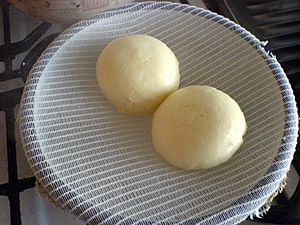Pampuchy facts for kids

Pampuchy whilst steamed
|
|
| Alternative names | Pączki, bułki, kluski na parze, pyzy drożdżowe, kluski parowe, parzaki, parowańce, parowce, buchty |
|---|---|
| Type | Dumpling |
| Course | Appetizer, main, dessert |
| Place of origin | Poland |
| Serving temperature | Hot |
| Main ingredients | Yeast dough |
Pampuchy are fluffy, steamed dumplings from Polish cuisine. They are made from a special dough that uses yeast, which makes them soft and bouncy. A single pampuch is usually oval-shaped and flat on the bottom.
You can enjoy pampuchy hot in many ways. They can be sweet, served with things like jam or fruit. Or, they can be savory, eaten with sauces or even meat. You can often buy uncooked pampuchy in most grocery stores in Poland.
Contents
Where the Name Comes From
The Polish word pampuch comes from the German word Pfannkuchen. This German word means 'pancake'. It combines the words Pfanne (which means 'pan') and Kuchen (which means 'cake'). So, it's a bit like how we say 'pancake' in English! A Ukrainian bun called Pampukh also got its name from pampuch.
Different Kinds of Pampuchy
Pampuchy are made and served differently across various regions in Poland. Here are some examples:
Kuyavia
In the Kuyavia region, pampuchy are called bułki na parze or pampuchy z Kujaw. These special dumplings are protected by the European Union. This means they are recognized as a unique food from that specific area.
Long ago, families in Kuyavia and Pomerania often ate these dumplings for dinner or as a snack. They usually served them with a savory sauce. Sometimes, they were eaten sweet with sour cream and sugar, or with fruit.
Lublin Land
The Polish Ministry of Agriculture lists several traditional pampuchy variations from the Lublin Land:
- Parowańce z kaszą jaglaną: These are parowańce (a type of pampuchy) filled with light millet kasza. They come from the area around Kąkolewnica village.
- Parowańce brzozowickie z kapustą i grzybami: These parowańce are from Brzozowica Mała village. They have a light filling of wild mushrooms and cabbage.
- Parowańce z serem: These parowańce are also from Kąkolewnica. They are filled with a light white cheese.
- Parowańce żakowolskie z soczewicą: From Żakowola Poprzeczna village, these are savory parowańce filled with ground lentils and fried onion.
Greater Poland
In the Poznań Land (part of Greater Poland), pampuchy are known by names like kluchy na łachu or parowce. The dough is made from yeast with a little milk, flour, sugar, and salt. Then, more flour, eggs, milk, and margarine are mixed in.
To cook them, a small cloth is placed in a pot. Small oval dough balls are put on the cloth, covered, and steamed for about 20 minutes. Traditionally, these pampuchy are served with red cabbage and roasted duck with apples. This dish is a special meal for celebrations in Poznań.
In the Kalisz Region, the dough for pyzy, parówki, or pampuchy is made with millet yeast, milk, sugar, flour, eggs, butter, and salt. People traditionally eat them with pork chops and sweet-sour fried white cabbage. Or, they can be stuffed with fruit and topped with melted butter, sugar, and cinnamon.
Upper Silesia
In Upper Silesia, pampuchy are called buchty. They are often served with berry kompot (a sweet fruit drink), plum jam, pork, sauerkraut, or simply with melted butter and sprinkled with sugar.
The buchty from Opole Silesia are called buchty śląskie. Since 2007, these "Silesian buchty" (or "steamed yeast dumplings") have been recognized as a traditional product by the Polish Ministry of Agriculture.

